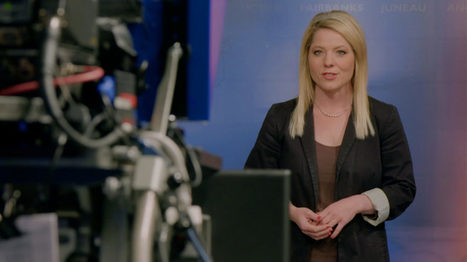 Your new post is loading...
 Your new post is loading...
Fresco is a lot like Uber. But unlike similar apps where you request a car, takeout, or a even a dog walker, Fresco puts a call out for a photojournalist. A newsroom posts a request for video of, say, a crime scene, and a Fresco user in the area can accept, take a video of it, and upload it to Fresco. If the news outlet uses it, the Fresco user gets paid $50.
TV news stations across the country are using the app, but Fresco is particularly appealing to KTBY, a station in Anchorage, Alaska. Alaska is a big state, and many of KTBY’s viewers live in remote villages that are hours away by plane. It’s hard to cover those communities without spending a ton of money and time. In a Fresco promotional video, Scott Centers, COO of Coastal Television Broadcasting Company, which owns KTBY, marvels that Fresco offers an affordable alternative.
If you thought you heard the last on fake news, you were sadly mistaken.
A Stanford study found that the majority of middle school students can’t tell the difference between real news and fake news. In fact, 82 percent couldn’t distinguish between a real news story on a website and a “sponsored content” post.
Of the 8,704 students studied (ranging in age from middle school to college level), four in ten high-school students believed that the region near Japan’s Fukushima nuclear plant was toxic after seeing an unsourced photo of deformed daisies coupled with a headline about the Japanese area. The photo, keep in mind, had no source or location attribution. Meanwhile, two out of every three middle-schoolers were fooled by an article on financial preparedness penned by a bank executive.
It seems that those surveyed in the study were judging validity of news on Twitter based on the amount of detail in the tweet and whether or not a large photo was attached, rather than focusing on the source of the tweet.
The WSJ, which first reported on the study, says that a big part of solving this problem among young people comes down to education, both at school and at home....
Local daily newspaper reporter?
How soon will we have to add this once-stable occupation to the list of jobs that once were — occupations once numerous that slid into obsolescence? (Not to mention the even more colorful spittleman [hospital attendant], rotarius [wheelwright], and hamberghmaker [horse collar maker].)
In this morning’s released annual census, the American Society of News Editors found its first double-digit decline in newsroom count since the Great Recession of seven years ago. Newsroom jobs dropped 10.4 percent — down to 32,900 full-time journalists at nearly 1,400 U.S. dailies, 2014 over 2013. That’s the loss of 3,800 jobs in just one year. (Detailed table at bottom of this column.)...
A 96-page internal New York Times report, sent to top executives last month by a committee led by the publisher’s son and obtained by BuzzFeed, paints a dark picture of a newsroom struggling more dramatically than is immediately visible to adjust to the digital world, a newsroom that is hampered primarily by its own storied culture.
The Times report was finalized March 24 by a committee of digitally oriented staffers led by reporter A.G. Sulzberger. His father, Times Publisher Arthur Sulzberger, fired Executive Editor Jill Abramson Tuesday, a decision that doesn’t appear immediately related to the paper’s digital weaknesses.
The report largely ignores legacy competitors and focuses on the new wave of digital companies, including First Look Media, Vox, Huffington Post, Business Insider, and BuzzFeed....
Kara Swisher, outspoken tech journalist, has a lot on her mind....
And then there’s you, whose wife, Megan Smith, is a VP at Google. I don’t have her money. Any of it. Which, I know, is stupid—she has a lot. We split everything 50/50. I went out of my way not to take her money because I wanted to make a point: I take it seriously. I don’t write about Google except to insult the company. Someone actually said once that I’m in the camp for Google, so I sent them my pieces, and they said, “You must have problems in your marriage because you’re so mean to Google.” I was like, “I do not, but thank you so much.” They were like, “Seriously, you could be nicer; they are pretty fantastic,” and I was like, “Not to me. I think they’re pretty dangerous and thuggish.” I’ve always said that...
I am often asked what it takes to be a great reporter in the digital era. The essential mission, I say, remains the same: to observe, collect and interpret information. Don’t be a generalist; pick a subject, dig deep into it, bring “passion” to the job. That word evokes the obligatory question about objectivity. My response: journalism has always entailed biases, conscious or not. Next, a great reporter engages one-on-one with news consumers, joins social news streams, learns to be a marketer and plays with the technology. I end with this: understand the business models behind the profession — and start to think like an entrepreneur. FORBES has 1,000 writers learning and practicing all of that. Here are four who are leading the way...
Twitter is a frenemy," said Jeff Zucker, CNN's new president, as reported by MediaShift. Jeff Zucker was describing the cable news network's relationship with social media and added, “the network uses, relies on -- and is scared by -- social media.” Twitter had a marquee moment last week, particularly late Friday afternoon and evening, that should scare most television news outlets in the business of reporting breaking news. That’s when Boston Marathon bombing suspect Dzhokhar Tsarnaev was cornered by police, trapped and almost bleeding to death inside a covered boat in a backyard in Watertown, Mass....
Yesterday I quoted my old boss at the New Statesman. Today it’s Jon Snow, Channel 4 News presenter and Charlie Beckett who now runs Polis at the London School of Economics and was previously a programme editor at Channel 4 News. Both had interesting things to say about the evolution of news in the networked age. Both were talking heads in the final part of Steve Richards’ Making News series on Radio 4....
In the wake of the Boston Marathon, I have but one ask for the media: please tell us NO.... ... While Twitter might offer up a 6-second video of one of yesterday’s horrific explosions, it’s your profession that is charged with relaying that information. In the race for clicks, pageviews, and traffic, I’ve seen the most trusted news sources with banner three-letter monikers devolve into sensationalized sites catering to this now now now generation’s demand for anything. “Anything — just give us anything,” we cry. But it would be lovely if you told us “no.” No – we will not capitalize on over-graphic images that would get a Hollywood blockbuster an R-rating. No – we will not use cultural or nationality indicators when reporting that there is a suspect in custody. Why? Because we know the most important words in those statements are “in” and “custody” as opposed to where one was born or the depth of one’s suntan....
“Twitter does its best work in the first five minutes after a disaster, and its worst in the twelve hours after that.” - @rolldiggity There is a quiet that descends in a newsroom when a big story breaks.... Twitter has often been touted as the “first with news”. From the miniscule to the massive. From Stephen Fry being stuck in a lift, to the Arab Spring rippling across North Africa, it is the instant source of a story, the first gurgle from a tap. The only way to find out what’s really happening, according to some. But I’m beginning to think that so-called truth is losing some of its polish. I follow about 700 people on Twitter. I actually “watch” about three times that amount. I have lists of people I don’t follow. In other words, I can see them, without having to follow them. News people, experts, specialists, comedians, doctors, police officers, bloggers and bohemians. I’ve been on Twitter for more than three years. I like to think I’ve found much of the gold within its mines. When the first tweets about the Boston marathon explosions popped up in my timeline, I went over to my newsroom colleagues. I told them what was happening. And the process began. And I watched Twitter....
... News is irrelevant. Out of the approximately 10,000 news stories you have read in the last 12 months, name one that – because you consumed it – allowed you to make a better decision about a serious matter affecting your life, your career or your business. The point is: the consumption of news is irrelevant to you. But people find it very difficult to recognise what's relevant. It's much easier to recognise what's new. The relevant versus the new is the fundamental battle of the current age. Media organisations want you to believe that news offers you some sort of a competitive advantage. Many fall for that. We get anxious when we're cut off from the flow of news. In reality, news consumption is a competitive disadvantage. The less news you consume, the bigger the advantage you have....
As more consumers access news on their mobile devices, news organizations are seeing traffic to their websites from desktop computers flatten or decline. And in some regions, such as many parts of Africa, users are leapfrogging the Web altogether and going straight to mobile. Although many newsroom leaders believe a "mobile, too" approach -- a focus on mobile in addition to other platforms -- will be enough, that mentality is shortsighted, Bergman said in a recent Poynter Online chat. Joining Bergman to discuss the news industry's transition to mobile were Poynter's Regina McCombs and Damon Kiesow, senior product manager for mobile at the Boston Globe and Boston.com. The chat included several helpful tips for newsrooms making the transition to mobile....
...Ad-supported journalism is being consumed in record quantities, but those of us who manage media companies face a stark reality: Traditional advertising dollars in print and broadcast become dimes on the full-scale web, and they tend to disappear entirely on mobile devices. Alternative revenue models, then, are key to success, but only if they follow ethics guidelines that protect media outlets from losing credibility with readers. Sponsored content, as it is now being published on the full-scale and mobile web, differs from old-fashioned print advertorial in significant ways. The biggest departure is that, rather than passively receiving and publishing advertorial copy from ad agencies, media outlets are more often partnering with brands to create custom-content “native advertising” campaigns that resonate with readers who fit the publication’s demographic profile. BuzzFeed, for instance, employs a large staff to craft brand-marketing pieces that readers will share with friends via Facebook and other social networks. One such recent post, “11 Things No One Wants To See You Instagram,” quickly drew 330,000 views on behalf of advertiser Virgin Mobile, the Wall Street Journal reported. Similarly, Forbes Media created a Forbes BrandVoice program through which brands can submit paid articles to the Forbes website. “The advertiser-sponsored copy appears in the same style and format as articles contributed by Forbes writers and editors,” New York Post media columnist Keith J. Kelly reported in November. (The BrandVoice connection is noted at the top of posts.) This is a Wild West moment for sponsored content...
|
The 2016 election exposed a significant crisis for U.S. democracy: the failure of our news media system.
This was an election in which false news was consumed as if true; in which polls were significantly off-base; in which journalists missed the stories both of Trump supporters, who came out in unanticipated numbers, and former Obama voters, who defied predictions to stay home.
The easy response, in the wake of these multiple failures, is to focus on one specific weakness. If only journalists had interviewed more white people in the Rust Belt! If only pollsters had looked at a different data-set! If only Facebook were not so dominant, or fake news sites so plentiful…
Such essays in search of simple answers represent no more than collective wishful thinking. Systemic failures have systemic causes. Repairs to the system may not be enough. We need to put time and resources now into transforming our news media system.
Why did we not know that voters in the Rust Belt were willing to vote for an anti-regulation racist populist, even when doing so might go against their values and self-interests? Likewise, why did news organizations fail to anticipate what appears to be a lower turnout of black voters in North Carolina (with its new voter suppression laws)?
It’s not that journalists in those communities were not doing their job; it’s that there are very few journalists left to tell the stories of those communities....
Some 23 per cent of news articles contain a social media embed, and 10 per cent of these embeds have either been modified or removed by their author since the article's publication, shows a report released today by SAM.
Social media curation platform SAM analysed one million web pages using its Report Card tool, focusing on North American news sites such as New York Daily News, Fox News, Vox, CNN or Forbes, to find out more about the role social media plays in newsgathering today.
The Report Card is available for free and enables publishers to find out how many social media embeds are currently on their websites and whether they have broken or they have been edited since publication....
It's called the Express Team. The New York Times has created a new newsroom unit to tackle the types of stories that are going viral on the web.Headed up by Patrick LaForge, the "Express Team" "will cover news that readers are searching for and talking about online, but also push that news forward rather than just repackaging it for clicks," according to a Tuesday afternoon staff memo signed by executive editor Dean Baquet, deputy executive editor Susan Chira, editor for innovation and strategy Kinsey Wilson, and assistant editor Clifford Levy.
"This new team will quickly and smartly weigh in on the issues and questions that are attracting attention across the day and around the world," they wrote.
The move comes as the Times' is becoming ever more aggressive about scaling its digital audience, which is becoming more important to revenue growth....
For a moment, let’s not focus on the delicious irony of Buzzfeed breaking the second biggest news about The New York Times this week. The site -- which many a Times staffer probably sniffs derisively at -- uploaded the paper-of-record’s entire 91-page “Innovation Report” that calls for de-emphasizing print in favor of a more sophisticated approach to digital. If you’re in digital, it’s even more intriguing than the news on Wednesday that executive editor Jill Abramson had been unceremoniously shown the door.
More than anything else, the report points to the Times’lackluster, scattershot approach to digital innovation, particularly in audience development, an imperative when so much content and readership comes from the act of sharing. In one of its many trenchant-but-obvious observations, it points out that “our digital content needs to travel on the backs of readers to find new readers.”...
Pew's annual omnibus report finds that the transition to digital, and the influx of new money and new ideas, only represents a sliver of activity in the broader media.
In Pew Research Center’s latest State of the News Media report, just out, you get a glimpse of how the worlds of journalism and technology are continuing to merge and the impact that convergence has on the business and editorial prospects of media companies.
A majority of Americans now say they get news through a digital platform: 82 percent reported using a desktop or laptop, while 54 percent got news through mobile devices, according to Pew. Half of social media users share or repost news stories, while 46 percent discuss news on those sites. Audiences are also spending more time watching their screens: 63 percent of U.S. adults now watch online video, and of that, 36 percent watch news video.
At the same time, the companies that are helping to redefine digital news are expanding aggressively: Pew estimates that digital news operations, from the small hyperlocal shops up to the likes of ProPublica, The Huffington Post, and Vice have produced almost 5,000 full-time editorial jobs. Not enough to make up for a decade of losses in newspapers, but significant....
The NYT’s multimedia project Snow Fall was a huge success, attracting big audiences and lots of plaudits. ...Snow Fall (and other such attempts) represent a great opportunity and the future for news organizations like The New York Times, especially as they are right now in a losing battle for attention with upstart competitors that include everyone from BuzzFeed to The Huffington Post. If you are the New York Times management, it is time to take a gamble: spend $25 million on creating 100 Snow Fall-like projects.... And in exchange, it got a few million page views, but I am guessing they also built a nice backend infrastructure to create more such projects. As a result, the next Snow Fall is going to cost less, with most future spending going to the creative: words, photos, other multimedia elements and design. So what will the Times (or someone like them) need to get it done? Simply put, a departure from the incumbent thinking, embracing today’s reality and re-imagining the work flow of a big city newspaper. In other words: Re-imagining its business model to factor in the reality of today’s world and forget the legacy of newsprint.Create a new breed of “producer” who can switch between Excel and content.Create a whole new breed of a journalist — one who has old-school values but also the ability to tell a story that works in many mediums of today.Build an editorial creative machine that works differently from a print-centric editorial group....
Traditional news organizations need to embrace the disruption brought by digital culture -- or they risk becoming obsolete. That was the message late last week at the International Symposium on Online Journalism hosted by the Knight Center for Journalism in the Americas at the University of Texas at Austin, where about 370 of the world's journalists, researchers and media watchers grappled with the hard questions for a beleaguered traditional media industry that is now more than a decade into its disruptive transformation. The problem is many media companies view digital technologies through a lens of traditional journalism and thus, fail to strategize properly, said Clark Gilbert, president and CEO of Deseret News Publishing Company. "In a post-disruption world, why would people pick up a paper at all? Why would someone turn on the 10 o'clock newscast?" Gilbert asked. "If you are not asking those fundamental questions, there is not a future for you legacy organization." The key to surviving? Innovate. Fail. Innovate again....
Guardian digital development editor Joanna Geary answers some questions about GuardianWitness.... ...First up: this was built in two months. The sponsorship pot from EE gave them a budget and time to get the job done, but not necessarily have everything they wanted at launch. She says it's a complete, working system that can be built upon. I suggest the phrase "minimum viable product" to Jo but she suggests that it's a full product - one that will be built on. Do they have aspirations for more integration with social media? Yes, they do. And it's something they're looking at as the system develops. The key part of the development which is invisible to us right now is that the Guardian Witness system is deeply integrated with the Guardian's CMS. Once the content has passed through verification, it's available to the journalists, and they can insert it into a story or liveblog just by inserting an URL, which creates an embedded version of the contribution that links back to the contributor's profile. "The really exciting thing is not what you see now, but what you see when Witness is included in a story," she says. It's a tool to facilitate genuine collaborative working between the journalist and external witnesses. Jo says they'll collaborate with people on the ground, or with expert knowledge, in any way they can - and already do, via phone and other traditional methods. This adds another tool for doing that....
Terrible events such as yesterday’s bombings at the Boston Marathon have always meant “all hands on deck” for news organizations, with staffers pulled off their regular beats to contribute. But the endpoint of the newsgathering and reporting is no longer a front-page package of stories explaining — the best one can — what happened, why it happened and what might be next. Now, there is no endpoint — events are reported in real time, with stories in constant motion, and the front page is a snapshot of an organization’s reporting at the moment when the presses needed to roll. Boston was a reminder of that, and a look at what’s changing in real-time journalism. Through Twitter and various live blogs, I found myself looking over my shoulder at the Boston Globe, the New York Times, Reuters and other news organizations, and was able to make some observations and draw some conclusions....
...You can access the app via the Web, but there’s also native incarnations for Android and iOS. To contribute content to GuardianWitness, you need to create an account, either using your existing Guardian credentials, or through your Facebook and Twitter details. The Guardian actually posts ‘assignments’, inviting users to post content based on themes – for example, when Britain experiences unseasonably bad weather. Editors set a range of assignments each week, covering news, sport, culture and life and style....
Don't be fooled by evangelists of 'free': editorial ethics and real reporting have been blown up along with the business model. Over at Slate the other day, Matthew Yglesias argued that journalism consumers are enjoying a "golden age". Yeah, sort of – in exactly the way looters enjoy an improved standard of living. Problem is, it only stays improved until the store is emptied out.
The news industry has gone from being obscenely profitable to slightly profitable to – at least, in the case of newspapers – largely unprofitable. All of that fantastic content Yglesias was gushing about is paid for by venture capitalists making bad bets, established media companies digging into their savings accounts to pay the bills, displaced workers earning peanuts, amateurs, semi-pros, volunteers and monks.
I would say that the business model is unsustainable, but losing money is not a business model. It is a going-out-of-business model....
Newspapers will never be the same. But what happens to democracy if the Web business model can't fund journalism? ...The assumption is that there has to be a way to make profits doing digital journalism if journalists and owners simply wise up and get with the program. Over the past few years, many American newspapers have been purchased on the cheap by hedge funds—nearly a third of the twenty-five largest dailies are now so owned—the subtext being that these business geniuses can generate profits where dummkopf journalism industry types have failed. As John Paton, the journalist-cum-CEO for a newspaper company purchased by the Alden Global Capital hedge fund in 2011, put it: “We have had 15 years to figure out the web and, as an industry, we newspaper people are no good at it.” Apparently, neither are the hedge fund managers. David Carr wrote in July 2012 that “hedge funds, which thought they had bought in at the bottom, are scrambling for exits that don’t exist.”...
|
 Your new post is loading...
Your new post is loading...
 Your new post is loading...
Your new post is loading...






































Cue and pay the citizen journalists.